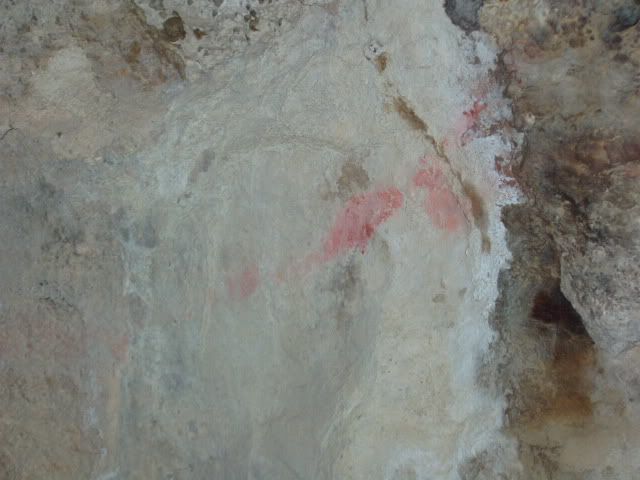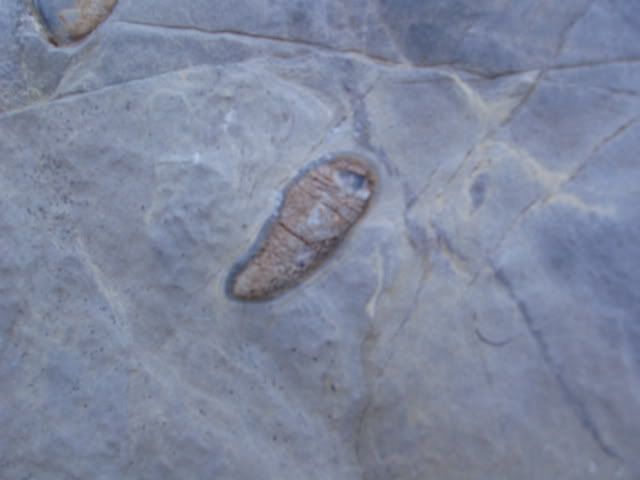Mitchell Caverns
Our next stop was Mitchell Caverns. Mitchell Caverns are within the boundary of the Mojave National Park. They are further down the 40 than Pisgah crater and within Park boundaries. They give tours at 1:30 on Weekdays, and three times a day on weekends. There were actually 15-20 people with us on the Wednesday we went, we were quite surprised at the turn out.
The caverns were most likely formed under the water table, where ground water trickled down through cracks in the limestone. When rainwater mixes with ground water it becomes undersaturated with calcite. The carbon dioxide in the water is lightly acidic to the limestone. The water dissolves a little of the limestone, mixing it with the calcite in the water. Then, when the water drips off the ceiling of the cave, it leaves behind a little ring of this solution.
Drip after drip the water falls, leaving a hollow hole in the middle of the stalactite it is forming. When this hole becomes plugged up, the water will drip down the outside, creating the classic icicle stalactite we all know. When the water hits the limestone floor, it begins to build stalagmites. When a stalactite and stalagmite meets, they form a column. Over time, the inside of the limestone formation is dissolved away into caves adorned with these formations.

This is the view from outside of Mitchell Caverns looking out over the valley. The flat mountain in the left center is Wildhorse Mesa. Wildhorse Mesa started as valleys and small hills. A violent volcanic eruption 15 miles away millions of years ago incased the valleys and hills in ash. The ash was more resistant to erosion than the surrounding, higher countryside. The surrounding area eroded away leaving the once low area as the predominate feature. I also assume Wildhorse Mesa could have had some help in growing with push up from volcanic or fault activity.

Turning around 180 from Wildhorse Mesa, these are the mountains that house the caves. The red rocks are made of ryolite, a magma as violent as basalt is fluid. The gray rock is what is left of the softer limestone. Most of it has eroded away from the ryolite.

We start our hike. Along side the wall is limestone intruded with quartz (white veins) and chert (orange). Both of these entered into the limestone when it was underground, much lower than its current 4,300 foot elevation.

Chert is a sedimentary rock made from decomposed ocean creatures, like sea sponge. It is much harder than the limestone around it, thus it stands out in relief from the limestone. These rocks are about 300 million years old.

The brown flowing stone that is on top of this limestone is aptly called flowstone, it is formed from the limestone and water that flows over the rocks.

Another picture of our view

this piece of limestone had a lot of quartz in it.

Entering the cave the ceiling was scared from fire, both from Native Americans and the “founder” of the caverns, Jack Mitchell in the 1930s. On the right wall we saw these markings. Perhaps drawn by the Native Americans.

A column

Behind this column you will see a flat disk connected to the wall. This is called a shield, and is very rare. They occur when there is pressure preventing the intruding water from dripping downwards, so instead it spreads out in a circular pattern.

And they are still growing! The last rains we had did a lot more than just wet the walls. The little one attached to the larger broken off one is 50 years old. If it took 50 years for this stalactite to grow one inch, imagine how old the other ones are (hand for scale).

looking up

A cool column with many rows of stalactites on it.

some ribbon like columns.

This break was probably caused by an earthquake. Look how the stalactites repair themselves. There was another fracture about two feet above this one.

Back outside. Those vertical spines of rock are the limestone, this is how it is being eroded away on this face.

After looking very hard, we found fossils. This little guy is a fusulinid, a one celled floating creature from the Pennsylvanian or Permian age.

More fossils

Quartz crystals coming up out of the limestone.

A large vain of quartz

speaking of erosion… water falling onto this rock caused the smooth depressions.
That as it for the caverns. We opted to skip the gift store and get back on the road, there were more wonders to be seen before night fall.
The caverns were most likely formed under the water table, where ground water trickled down through cracks in the limestone. When rainwater mixes with ground water it becomes undersaturated with calcite. The carbon dioxide in the water is lightly acidic to the limestone. The water dissolves a little of the limestone, mixing it with the calcite in the water. Then, when the water drips off the ceiling of the cave, it leaves behind a little ring of this solution.
Drip after drip the water falls, leaving a hollow hole in the middle of the stalactite it is forming. When this hole becomes plugged up, the water will drip down the outside, creating the classic icicle stalactite we all know. When the water hits the limestone floor, it begins to build stalagmites. When a stalactite and stalagmite meets, they form a column. Over time, the inside of the limestone formation is dissolved away into caves adorned with these formations.

This is the view from outside of Mitchell Caverns looking out over the valley. The flat mountain in the left center is Wildhorse Mesa. Wildhorse Mesa started as valleys and small hills. A violent volcanic eruption 15 miles away millions of years ago incased the valleys and hills in ash. The ash was more resistant to erosion than the surrounding, higher countryside. The surrounding area eroded away leaving the once low area as the predominate feature. I also assume Wildhorse Mesa could have had some help in growing with push up from volcanic or fault activity.

Turning around 180 from Wildhorse Mesa, these are the mountains that house the caves. The red rocks are made of ryolite, a magma as violent as basalt is fluid. The gray rock is what is left of the softer limestone. Most of it has eroded away from the ryolite.

We start our hike. Along side the wall is limestone intruded with quartz (white veins) and chert (orange). Both of these entered into the limestone when it was underground, much lower than its current 4,300 foot elevation.

Chert is a sedimentary rock made from decomposed ocean creatures, like sea sponge. It is much harder than the limestone around it, thus it stands out in relief from the limestone. These rocks are about 300 million years old.

The brown flowing stone that is on top of this limestone is aptly called flowstone, it is formed from the limestone and water that flows over the rocks.

Another picture of our view

this piece of limestone had a lot of quartz in it.

Entering the cave the ceiling was scared from fire, both from Native Americans and the “founder” of the caverns, Jack Mitchell in the 1930s. On the right wall we saw these markings. Perhaps drawn by the Native Americans.

A column

Behind this column you will see a flat disk connected to the wall. This is called a shield, and is very rare. They occur when there is pressure preventing the intruding water from dripping downwards, so instead it spreads out in a circular pattern.

And they are still growing! The last rains we had did a lot more than just wet the walls. The little one attached to the larger broken off one is 50 years old. If it took 50 years for this stalactite to grow one inch, imagine how old the other ones are (hand for scale).

looking up

A cool column with many rows of stalactites on it.

some ribbon like columns.

This break was probably caused by an earthquake. Look how the stalactites repair themselves. There was another fracture about two feet above this one.

Back outside. Those vertical spines of rock are the limestone, this is how it is being eroded away on this face.

After looking very hard, we found fossils. This little guy is a fusulinid, a one celled floating creature from the Pennsylvanian or Permian age.

More fossils

Quartz crystals coming up out of the limestone.

A large vain of quartz

speaking of erosion… water falling onto this rock caused the smooth depressions.
That as it for the caverns. We opted to skip the gift store and get back on the road, there were more wonders to be seen before night fall.

0 Comments:
Post a Comment
<< Home